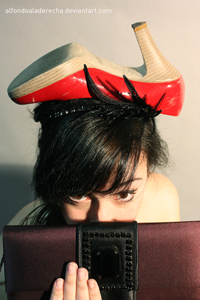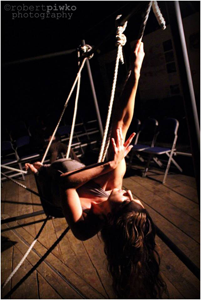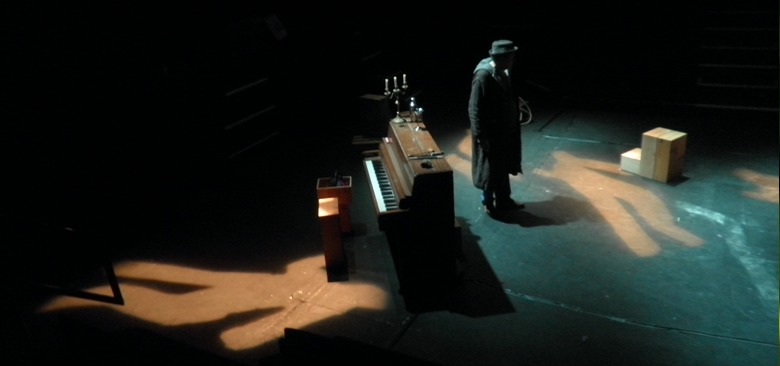I came to London to do an MA in Set Design at the Royal Central School of Speech and Drama. It has really opened my eyes and given me lots of great opportunities. I am currently a member of the Society of British Designers and I have contributed to their magazine, Blue Pages. I started working with Second Skin Theatre just a few days after I handed in the final project for my Masters. Real life is not at all like working on speculative projects, there are so many limitations: space, budget… but in some sense I can turn these to my advantage; it allows me to use my creativity to the full
“Fare Ala”… say no more… even though I don’t speak Italian I have already passed through the fairy’s paper-thin wing, the wing that is fluttering and letting off metallic sparks. El Hala del Hada, the fairy’s wing… us Latin people already understand it. What took you to Italy? What did you get out of it? Did you take what you learned to London with you?
Everything seemed to fall into place when I arrived in Italy. It was my two great passions that lead me there: music and art. Italy, the cradle of opera. Opera, the fusion of all the arts: painting, sculpture, dance, poetry, music, cinema… a perfect combination. From the moment I first set foot in the marvellous Politeama theatre, I knew I wanted to spend the rest of the year there. As the months went on, I also had the opportunity to work as a set designer in Europe’s third biggest opera house, the colossal and magical Teatro Massimo.
Fare Ala’s blog unfolds like an infinite butterfly; there is no way of finding the beginning or the end. Was this the ultimate goal of the group, or movement? The fragments of your work don’t reveal purely aesthetic motivations, am I right? Tell us more.
Did you know that the Italian for butterfly is farfalla? What a coincidence that you should mention it…. In fact, the group’s logo, its starting point and emblem shows two dirty hands joined together to form wings (maybe a butterfly’s wings…). In part, it represents the idea of “getting your hands dirty” – hard work ranging from self-publishing to street art – although it also reflects the idea of work that is both collaborative and interdisciplinary.
It all started one day in October 2009, in a small room in the Accademia di Belle Arti di Palermo (Italy), where a group of young Erasmus students and Italians got together with the intention of doing something creative and innovative. From that day onwards, things have snowballed. The group keeps getting bigger and bigger. The members of Fare Ala go their separate ways, finding new audiences for their works across the world (Murcia, Seville, Bilbao, Alicante, Rome, London, Venice, Florianópolis (Brazil), Córdoba (Argentina)), and getting new artists involved. We’re all constantly in contact with one another, turning the distance that separates each hub and the connections between them into fundamental ingredients for the development of each new project. We hope that this “snowball” will keep rolling for a long time. Ana Inés Jabares Pita. Photo © Carmen Almenza
Tell us about your projects, the ones where you masterfully pick up your pencil to sketch outlines that are sometimes perfectly defined and other times unfinished. Is there a deep motivation for these sketches, or are they simply guided by the script? Do your set designs stem from inside of you? What are the fundamental things that stop your personal vision from getting lost? Or does having to change some element or other or having to improvise sometimes give you a better result?
The sketches emerge of their own accord and are usually unpredictable…
There are always rules, scripts, guidelines or limitations that I either try to overcome in some way, or else turn them into something positive.
When I paint and draw I just go with the flow, although unfortunately I haven’t sat down to do that for quite a while because most of my time has been occupied with set design.
My designs don’t really stem from me. They generally stem from a word in the script, a sound, a note… the only thing I have to do is to pay attention to those details and stimuli so that I can recreate an atmosphere, a feeling from them…
The projects that I feel most comfortable doing are the collaborative ones. Everyone brings ideas to the table; balance is fundamental to working as a team. Each member of the group has a speciality but we all get involved and give our opinions on the specialities of others so that the finished product works as a coherent whole. But the specialist in each area always has the last word on their discipline. We nurture one another, and learn something new from every project.
I think it’s great to stand up for your own ideas but also to realise when someone is giving you good advice, and know when to take it or leave it. I never thought dialogue or oral expression would be so useful in my work, although I frequently use drawings and diagrams to explain my ideas, as that’s the way I express myself best.
The themes and issues raised in these stage projects are also varied, from the more conventional fusion of classical ballet and contemporary dance found in “Pierrot Lunaire”, through to a performance of Donizetti’s “Elisir d’amore” set in a butcher’s shop or “The Incarnation of Una Furtiva Lagrima” to en entirely sensory project about his contemporary, Beckett, (“Ill Seen Ill Said”). There seems to be an emphasis on creativity. Are appearances deceptive?
Appearances don’t usually deceive…
I value creativity a lot. There are three fundamental tenets I try to keep to in my work: originality, simplicity, and elegance. That’s what all my work is founded on, although some people might argue that setting “Elisir d’amore” in a butcher’s shop is not exactly “elegant”. I think that having Nemorino sing one of the most beautiful bel-canto arias, ‘Una Furtiva Lagrima’, as a butcher, in a fridge surrounded by meat, emphasises the beauty of his voice and of the music.
I always start from very simple ideas, which I embellish little by little to give them new meaning.
I like my sets to take on a life of their own during the performance, rather than just being a beautiful but useless picture frame. I think it is fundamentally important that the design contributes something to the overall drama of the piece. Sappho © Robert Piwko
Does the multidisciplinary approach that you go for have anything to do with your varied artistic background? Could you tell us more about this? Which aspect of your training has the biggest influence on your work? To return to Fare Ala, I have an image in my head of a network of beautiful old switches that turn on and off of their own accord. But you’re the best person to shed some light on this matter…
Everything I do, I do because of who I am, consciously or unconsciously. I think that in one way or another everything you have been through is reflected in your work, in some sense you are baring all. Little by little, each person is accumulating his or her own personal vocabulary.
Visual art and music are both equally present in my work. I recently realised that my inspiration comes from music and sound, which then transforms into something visual and material, so I think that the two sources are quite balanced. I miss actively making music, I miss singing, although sometimes I do have the opportunity to collaborate with the choir Coro Gaos. I really enjoy singing with them. Each of the things I do brings me different experiences and sensations.
It’s a very strong image, that room full of switches of different shapes and colours that connect different lights and currents and sometimes meet. I really can’t think of a better way to express it.
And whilst we are talking about the murky recesses of your memory, let’s talk about the darkest, most mysterious surroundings you like to immerse us in. Although you give us a way out, there we are still, curiously looking on. You give us a starting point, and that’s great. Does it lead anywhere in particular?
I think my designs are the phonemes of new words, of a new lexicon. I am looking for the perfect set design, which I never really expect to find, so I’ll be able to keep on searching and experimenting for the rest of my life.
This year I have been swamped with theatre and experimental work. I generally focus on experimenting with opera, although I haven’t written off other disciplines; life can bring some wonderful surprises.
Talking of new beginnings… how has your time in London been so far? How was your last show received? A little bird told us that you are working on a new project at the moment.
First of all I want to say that I really think the conclusions you have reached about my work are amazing, really inspiring. I’ve never had anyone talk to me about my work in such depth before. It tells me a lot about how to see what I do through the eyes of others, and that’s something I value highly.
I came to London to do an MA in Set Design at the Royal Central School of Speech and Drama. It has really opened my eyes and given me lots of great opportunities. I am currently a member of the Society of British Designers and I have contributed to their magazine, Blue Pages. I started working with Second Skin Theatre just a few days after I handed in the final project for my Master’s. Real life is not at all like working on speculative projects, there are so many limitations: space, budget… but in some sense I can turn these to my advantage; it allows me to use my creativity to the full.
May has been a pretty intense month, first I designed the set for “The Freedom Plays” by Sarita Plowman at the Courtyard Theatre, followed almost straight away by “Hamlet’s Fool”, written and performed by Peter Cutts at the Cockpit Theatre. At the moment we are putting on a new version of “A Picture of Dorian Grey” by Rob Johnston, directed by Andy McQuade, which is full of surprises. And we are returning to Sappho… It’s a version in 9 fragments directed by Jessica Ruano, but this time in the Rose Theatre, a spectacular, inspiring venue where Shakespeare made his first forays into the world of drama.
Fortunately, I’ve got lots of work on this summer. I can’t wait to be able to start working in Spain. All being well I will start my first project on home turf, in Galicia, quite soon. Fingers crossed.
Thank you very much for everything. See you soon.
Ana Inés Jabarés Pita’s blog: http://anainesjabarespita.blogspot.co.uk

